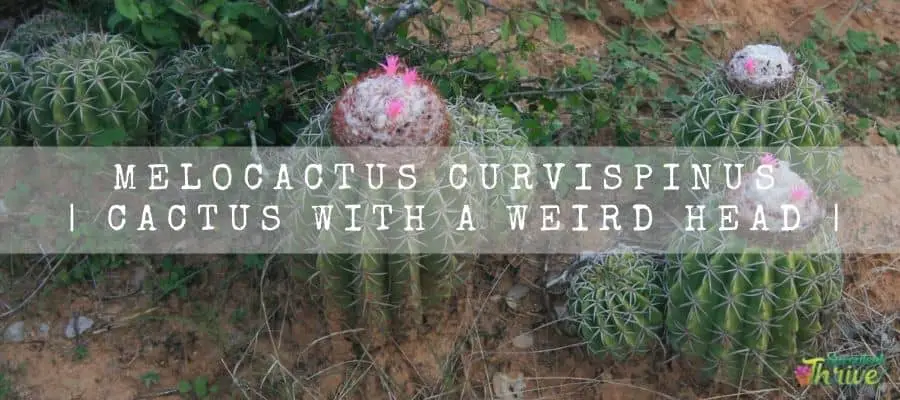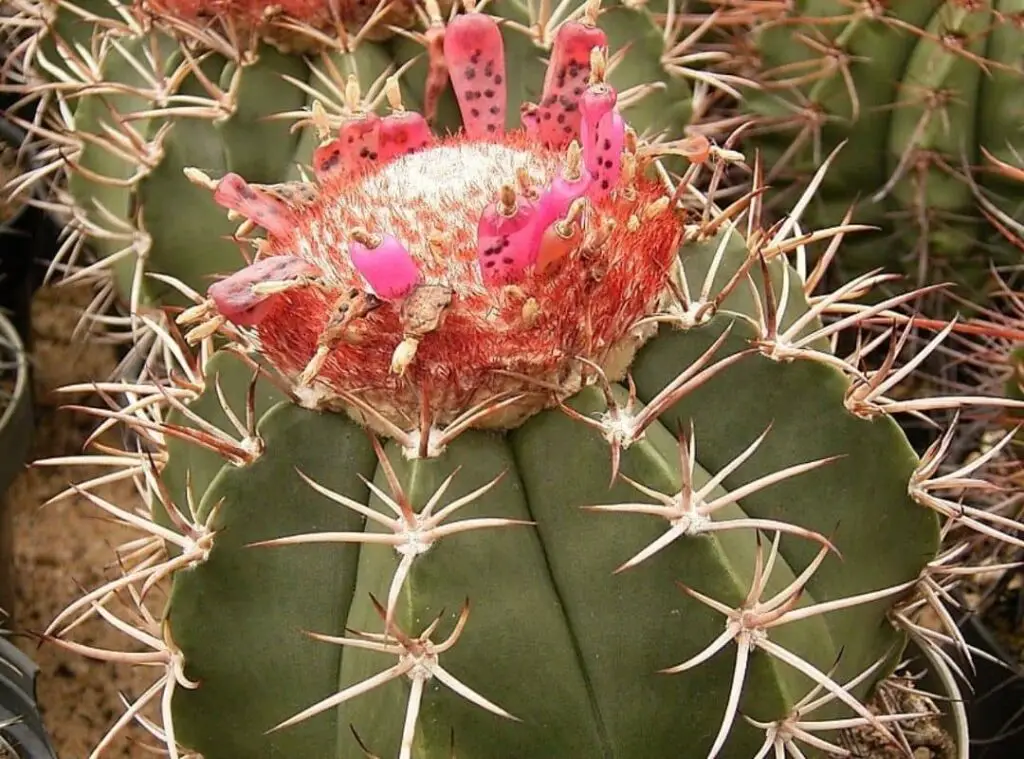Melocactus curvispinus cactus is yet another attractive cactus in the cactus world. To elaborate further on the family cactaceae, it has about 40 species.
They are endemic plants to Mexico and to the south of Peru. These are some interesting plants which many people tend to grow and I will be covering how you should look after them when you start growing.
Further I will be covering the propagation methods of Melocactus curvispinus cactus and on the common bugs and the illnesses they may come across as well.
Turk’s cap cactus is what you could commonly call these plants. Melocactus curvispinus cactus’s main highlight is their reddish cap-like structure.
Further, they are commonly known as Turk’s cap cactus due to this special structure.

How do I identify Melocactus curvispinus?
You can identify the Melocactus curvispinus cactus by looking at their red and woolen cap-like structure. It is a distinctive feature of them.
This structure usually forms on the top of the Melocactus curvispinus cactus. They are full of bristles and it will start flowering from the bristles.
This is a cactus which you can spot in blue-green color. Further they may carry a globose body as well. They would reach a maximum height of 30 cm when they grow to their best.
Besides, they may consist of about 10-16 ribs too. Furthermore, they would carry oval shaped wooly areolas too.
Melocactus curvispinus cactus cephalium may carry 6-11 radial spines and 1-4 central spines. The radial spine would be curved.
The whole cactus would reach a maximum height of 1 foot when they grow to their best potential.
Besides these features, Melocactus curvispinus cactus produce flowers in magenta color and they would be small.
Size of the plant
They would reach a maximum height of one foot.
Growth rate
They usually grows at a slow rate.
One look care guide
| Botanical Name | Melocactus curvispinus |
| Common Name | Turk’s cap cactus |
| Plant Type | Cactus |
| Mature Size | One foot in height |
| Sun Exposure | Full sunlight to partial shade |
| Soil Type | Well draining / Sandy |
| Soil pH | Neutral |
| Bloom Time | Spring |
| Flower Color | Magenta |
| Hardiness Zones | USDA hardiness zones 11. |
| Native Area | Mexico |
| Toxicity | Non toxic |
How do you take care of Melocactus curvispinus?
Light Requirement
The exposure for full sunlight would be optimal for the Melocactus curvispinus vigorous growth. Having said that, they would love to have partial shade during the intense summertime.
It is important that you fulfill their sunlight requirement as it will have a greater impact on the plants’ firm growth.
Temperature and humidity
They prefer to have warm temperatures right throughout. Literally they would not stand temperatures below 15 degrees Celsius.
Is it cold hardy?
However, do not expose them to colder temperatures for too long as it will be unhealthy for them.
USDA Hardiness Zone
They are hardy in USDA hardiness zones 11.
Watering Requirement
They require little more water when compared to the rest of other succulents and to cacti.
Literally you need to water them once every 10 days during spring and once every five to seven days in summer.
On the other hand, minimize watering them ti once every 15-18 days during fall. You can suspend watering them in winter completely.

Soil Requirement Type / pH.
Soil medium which has good drainage would be optimal for the vigorous growth of the Melocactus curvispinus.
Ensure that you do not let their soil mix to be bone dry at all. On the other hand, it should not retain excess moisture.
You may consider growing them in a substrate which has 75 % of healthier soil and 25 % of coarse sand.
Pot size Potting and Repotting
You can go ahead with a pot which is made out of a porous material to grow the Melocactus curvispinus.
Moreover, ensure that your container has good drainage too. When it comes to repotting, I recommend doing that during the start of the growing season.
You can repot the them in the same way you repot the other succulents and cactus.
Literally you need to lift the root ball of the Melocactus curvispinus and take the plant out from the pot. Next, clean the cactus from its old soil and then plant them in a fresh soil mix.
Where to Plant
As aforesaid, you need to plant the Melocactus curvispinus in a spot where they can gain sufficient sunlight. It has a great impact on maintaining the good health of the plants.
Fertilizer and time of year
They have minimal demand when it comes to fertilizing. Feeding them once every four weeks during their active growing season would be helpful for them.
Further a fertilizer which is enriched with Phosphorus, and potassium would suit them the best. You may apply these fertilizers during summer.
Flower
They produce flowers which you could spot in magenta. Their flowering season would be spring
Dormancy
Toxicity
These plants consider non toxic to human and animals
Common bugs and illnesses
Melocactus curvispinus are strong contenders when it comes to resisting the pests’ attacks and diseases. However , the faults you do in watering would contribute to root rot.
Having said that , chances are that regular pests such as Mealybugs, aphids, and scale may attack the plants.
How to propagate Melocactus curvispinus
You can use the seeds propagation method to propagate the Melocactus curvispinus.
Consider conducting the seeds propagation during spring. However, it is a slow process, and it would take a little longer to form the roots from seeds.
Conclusion
Before wrapping this up, trust this article gives you a broader view of how you should look after the Melocactus curvispinus well.
Moreover, Hope this article was useful for you to learn about the propagation methods of the Melocactus curvispinus as well. So, Happy cultivating with Melocactus curvispinus!
Read Next : Melocactus Matanzanus | Cactus With A Weird Head | Melocactus Rubrispinus | Cactus With Weird Head |
